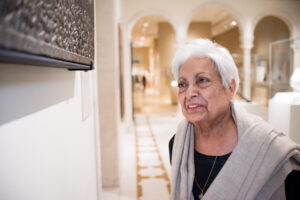Indian-origin artists shaping contemporary art

Babneet Lakhesar's powerful stance as a woman of South Asian heritage occupies much of her commanding paintings
“Contemporary art is the art of today, produced in the second half of the 20th century or in the 21st century. Contemporary artists work in a globally influenced, culturally diverse, and technologically advancing world, they have moved away from the traditional method of using a brush on canvas,” Karan Singh, an Indian-Australian contemporary artist tells Media India Group.
Singh says India’s thriving art world is growing fast and the strength of Indian-origin artists has been recognised internationally. Many renowned art galleries around the world, including the MET, have kept Indian artists’ works on display Indian artists bring the feeling of ‘Indian-ness’ in their work.
Singh is one of the most well-known figures among contemporary Indian artists overseas. He talks about the amalgamation of immigration, nostalgia and that Indian-origin artists bring in their artwork. The demand for buying, displaying and studying such works of art has also increased manifold in recent year. Here is a list of five artists from Indian diaspora that have been shaping up contemporary art around the world.
Karan Singh, Australia
Born in Australia in 1985, Karan Singh is an artist and illustrator. His bold and vibrant work is a playful interpretation of minimalism particularly focusing on depth and dimension through pattern and repetition.
While he studied interaction design, the self-taught artist has focused on visual arts and illustration for the past twelve years, drawing inspiration from graphic design sensibilities and op-art minimalism. Using vibrant, bold colours, patterns and strong vectors, his work is reminiscent of the Japanese artist Yayoi Kusama, in terms of pattern repetitions. Singh acknowledges the influence of Japanese artists in his work.
“I did not think much. I decided to take a course called ‘design computing’ at the University of Sydney. The decision was based on what I liked rather than thinking of where it might take me in terms of my career,” he says.
Babneet Lakhesar, Canada
Based in Toronto since 2000, Babneet Lakhesar was born in Jaipur, Rajasthan and Indian elements find their way into her multi-faceted artistic works. Be it painting, graphics or designing clothes – Babbu the painter, as she’s known popularly in the online world, has her toes dipped in all the vibrant pools of tongue-in-cheek humour. The ‘#BadBeti’ movement initiated by her and artist Maria Qamar took the internet by storm in 2018.
Heavily influenced by pop art and Bollywood’s stereotyping of women, Babneet’s take on Indian culture is through the unique lens of an immigrant living in Toronto.
Her powerful stance as a woman of South Asian heritage occupies much of her commanding paintings, graphic drawings, and photography. In her work, she is present as a model but also occupies the behind-the-scenes roles of stylist, photographer, and creative director.
Aakash Nihalani, New York
Born in 1986 in New York, in an Indian household, Nihalani is known for his 3D geometric illusions made with tape. Nihalani uses bright, bold lines at the forefront of all of his art as a means of visually creating 3D images on two-dimensional surfaces.
The repetition of isometric squares and rectangles becomes visually pleasing to the eye, conveying complexities such as movement and space by something so simple as the placement of a line.
In 2013, Nihalani was commissioned by the Parrish Art Museum in Water Mill, New York, to create three ephemeral tape installations for their Herzog & de Meuron-designed museum’s exterior wall. The pieces could be appreciated during their annual Midsummer Party and throughout the summer months, coinciding with his solo exhibition arranged at Tripoli Gallery in Southampton. Nihalani’s colourful work has been exhibited internationally and featured in a number of publications. He has been part of group exhibitions throughout New York, Rome, New Delhi and London, and featured in the Urban Nation exhibition UN-DERSTAND The Power of Art as a Social Architect in Berlin in 2020.
Sheela Gowda, Switzerland
Born in Bhadravati, Karnataka in 1957, and a graduate from Viswa-Bharti University, Shantiniketan, Sheela Gowda went on to study painting at the Royal College of Art in London in 1986 and moved on to settle in Switzerland. “I respond to my environment and the heady, rambunctious ins-and-outs of everyday life and work in Bangalore are my fodder,” explains Sheela Gowda herself.
Using materials associated with the India – human hair talismans, cow dung, kumkum (red turmeric), incense, tar drums – she creates large installations and sculptures that captivate the surroundings.
Working painstakingly by hand, Gowda employs craft techniques, responding to the status of manual labour in the face of India’s social and economic metamorphosis, as well as its implication in the fabrication of art.
She often looks towards disenfranchised and marginalised communities in India to create staggering works such as Behold (2009), which was acquired by the Tate art gallery, London, in 2014. The work is composed of four km of knotted rope swinging from 20 car bumpers, suspended by tight plaits of human hair. It responds to the tension between India’s fierce urban aspirations and the religious economy in which hair is donated to temples to form talismans or sold for profit.
Zarina Hashmi, New York
Born in Aligarh, Uttar Pradesh in 1937, Zarina Hashmi received a degree in mathematics from Aligarh Muslim University and went on to study woodblock printing in Bangkok and Tokyo, and intaglio with S. W. Hayter at Atelier-17 in Paris.
Hashmi, who preferred to identify herself professionally by only her first name, became internationally known for woodcuts and intaglio prints, many combining semiabstract images of houses and cities she had lived in accompanied by inscriptions written in Urdu. She hoped to evoke and pin down a sense of home through minimal monochrome prints, canvases, intimate drawings, elegant sculptures, and cast papers caked in layers of gold flake. Zarina was one of India’s few female artists of her generation, including M. F. Husain and Tyeb Mehta, amongst others. Zarina was part of India’s first-ever national pavilion at the 54th Venice Biennale in 2011.
Her experiences and her personal life define her works. An early interest in architecture and mathematics is reflected in her use of geometry and her emphasis on structural purity. While her work tends towards minimalism, its starkness is tempered by its texture and materiality. Her art poignantly chronicles her life and features recurring themes of home, displacement, borders, journey, and memory.
In the course of her career, Zarina exhibited at numerous international venues. In 2012, her retrospective exhibition, entitled Zarina: Paper Like Skin, opened at the Hammer Museum in Los Angeles, before travelling to the Guggenheim Museum in New York and the Art Institute of Chicago in 2013. She died on April 25, 2020, in London at 82, succumbing to complications of Alzheimer.












